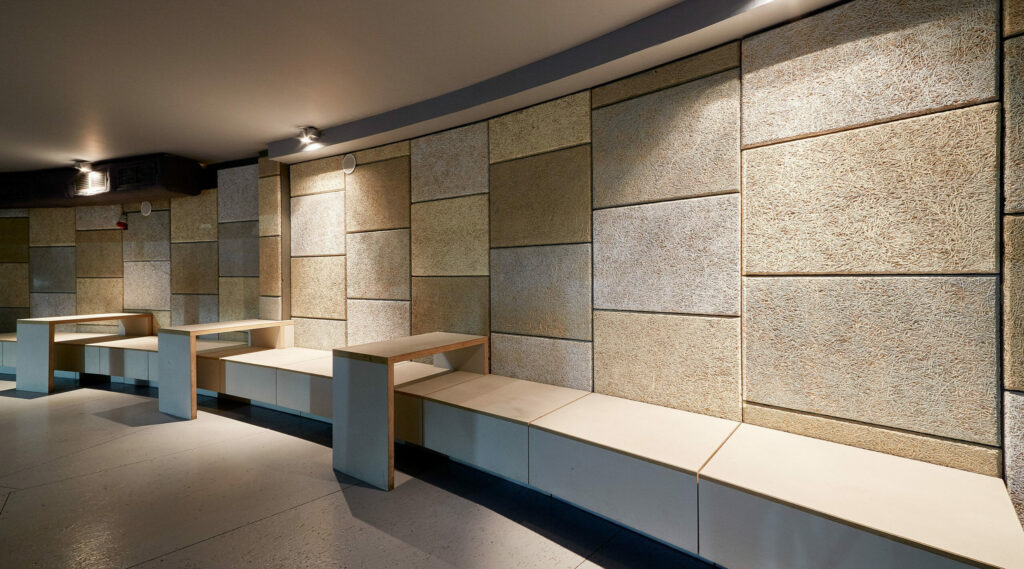Sound Control 101: Acoustic Panels vs. Soundproofing MeasuresThe Architecture Designs

Acoustic panels and soundproofing are often mentioned as methods for enhancing sound quality in a space. Although both deal with sound management, they serve different purposes and employ distinct methods. This article will delve into the dissimilarities between acoustic panels and soundproofing, grasp their functionality, and help you determine the appropriate solution for your needs.
Understanding acoustic panels
Acoustic or sound-absorbing panels are specially crafted materials that regulate and diminish sound reflections within a room. Typically, these panels are made from materials that absorb sound energy, such as foam, fiberglass, or fabric-wrapped panels.
How do acoustic panels work?
source: pinterest.com
Acoustic panels capture sound waves and convert their energy into heat through absorption. When sound waves collide with the surface of an acoustic panel, the porous material within the panel traps the sound energy and diminishes its reflection back into the room. This absorption process aids in reducing echo, reverb, and overall noise levels within the space. If you’re looking for top-notch quality acoustic panels, consider exploring Acousthetics.
Benefits of acoustic panels
The utilization of acoustic panels provides several advantages. Firstly, they enhance speech intelligibility by reducing echo and reverberation, making it easier to comprehend spoken words. Secondly, they augment the overall acoustic quality of a room, ensuring a balanced sound environment. Moreover, acoustic panels can reduce stress, increase productivity, and create a comfortable and pleasant atmosphere.
Types of acoustic panels
source: pinterest.com
Common acoustic panels include foam, fabric-wrapped, perforated, diffusive, and ceiling clouds. The selection of acoustic panels depends on factors such as room size, purpose, and desired visual appearance.
The concept of soundproofing
Soundproofing involves reducing the transmission of sound from one area to another. Its objective is to impede or dampen the sound waves that pass through walls, floors, and ceilings, thus preventing them from entering or exiting a space. Soundproofing is often employed in spaces where privacy, noise control, or compliance with local noise regulations are necessary.
How does soundproofing work?
Soundproofing employs various techniques to minimize sound transmission. These techniques include adding mass to surfaces, creating airtight barriers, decoupling structures to prevent vibrations, and using sound-absorbing materials. By implementing these methods, soundproofing helps isolate and contain sound within a particular area, reducing its impact on neighboring spaces.
Advantages of soundproofing
Soundproofing offers several benefits. It ensures privacy by preventing sound from escaping a room, making it ideal for recording studios, conference rooms, or home theaters. Soundproofing also aids in reducing external noise, such as traffic or loud neighbors, thereby creating a quieter and more peaceful environment.
Different methods of soundproofing
source: pinterest.com
Various soundproofing methods exist, including installing acoustic insulation, employing resilient channels, sealing gaps and cracks, adding mass-loaded vinyl barriers, and upgrading doors and windows. The choice of soundproofing methods depends on the desired noise reduction level and the space’s specific characteristics.
Acoustic panels vs. soundproofing
Distinct purposes
Acoustic panels and soundproofing serve different objectives. Acoustic panels primarily focus on improving the sound quality within a room by reducing echoes and reverberations. They are commonly utilized in recording studios, home theaters, auditoriums, and restaurants to create a more enjoyable listening experience. Conversely, soundproofing aims to prevent sound from entering or exiting a space, guaranteeing privacy and reducing noise transmission between different areas.
Functionality and applications
Acoustic panels effectively absorb and control sound reflections within a room, enhancing acoustics for better speech intelligibility and audio quality. They benefit environments with crucial sound clarity, such as music production studios or lecture halls. On the other hand, soundproofing is essential in spaces where noise control and privacy are paramount, such as bedrooms, offices, or commercial buildings in bustling areas.
Comparative effectiveness
source: pinterest.com
Acoustic panels effectively reduce echoes and reverberations, resulting in excellent sound quality within a room. However, they have a limited impact on blocking sound transmission through walls or other barriers. Soundproofing, conversely, is designed to prevent sound from passing through surfaces, making it highly effective in reducing noise transfer. Soundproofing measures’ effectiveness depends on the techniques employed and the level of sound isolation required.
Combining acoustic panels and soundproofing
In many cases, combining acoustic panels and soundproofing techniques yields optimal results. Installing acoustic panels alongside soundproofing measures can improve sound quality within a room while minimizing sound transmission to and from surrounding areas. This combined approach is often employed in professional recording studios, home theaters, and other spaces where sound clarity and privacy are vital.
Final words
Acoustic panels and soundproofing are two distinct approaches to managing sound in a space. You can make a well-informed choice by comprehending your needs, considering budget constraints, and evaluating practicality and aesthetics. Combining acoustic panels and soundproofing techniques can offer optimal results, providing improved acoustics and reduced noise transfer.
The post Sound Control 101: Acoustic Panels vs. Soundproofing Measures appeared first on The Architecture Designs.





